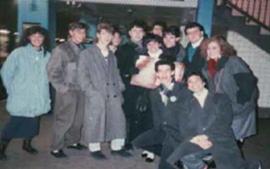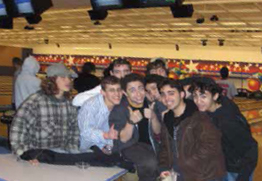Landmark Initiative Begins With a Video Interview of an NCSY Legend
What began as a personal quest will result in a historical record of one of the most successful Jewish outreach efforts in the history of the American Jewish community.
It all started at last year’s Ben Zakkai Dinner, the evening celebrating NCSY’s prestigious honor society. Rabbi Yehoshua Marchuck, director of OU Alumni Connections, sought out Rabbi Pinchas Stolper, who had been NCSY’s first national director in 1959 and nursed the organization through its infancy to the global teen-led outreach effort that it is today.
Rabbi Stolper’s extraordinary vision of the potential power of a teen Torah outreach organization ran counter to the prevailing assimilationist winds of the era. “The map of America could be redrawn if one only had the willpower and stomach to buck the tide,” Rabbi Stolper wrote at the time.
Rabbi Marchuck’s quest was a personal one. He had grown up in a traditional Jewish home, became involved with NCSY as a teenager and has been active in outreach and Jewish education ever since. He passionately felt that it is time to document the founding and growth of this dynamic youth movement which over the years had, as Rabbi Stolper predicted, snatched thousands of teens from sterile Jewish lives and brought them into the warm sphere of Torah observance. “No one has greater historical knowledge about NCSY than Rabbi Stolper,” he explained.
Rabbi Stolper agreed to do the video interview, but had one concern: it would be a bit difficult to meet, since he had moved from the east coast to Chicago. Two months later, while attending a regional convention in the area, Rabbi Marchuck visited Rabbi Stolper in his home. The two spent hours talking and Rabbi Marchuck captured it all on videotape.
Rabbi David Felsenthal, the director of the Orthodox Union’s NextGen division, quickly realized the importance of the effort. From that initial interview, he decided to broaden the idea to reaching out to many who were involved in the first few years of NCSY − as advisors or NCSYers. He felt that there are so many people whose stories must be told, before they are lost to the next generation. The plan is to post the videos to a YouTube channel dedicated to the topic.
Rabbi Felsenthal also had a specific model in mind. “We want to pattern it after the testimonials of the Shoah,” he said. “Everybody always says the NCSY stories are unbelievable. But they are believable to those who lived them, and an inspiration to all who hear them. It’s time we preserved those stories so they can be shared.”
“The history of American Jewry cannot avoid a chapter titled ‘NCSY,’” Rabbi Marchuck added. “The Orthodox Jews of America owe a tremendous debt of gratitude to NCSY.”
Rabbi Felsenthal also believes that the video archive is in line with NCSY’s overall goals. “Our mission is to empower and impassion Jewish teens, but this video archive will impassion the older generation as well. We’re showing them how valuable they are and how valuable their experiences are.”
During the landmark interview, the most important moment for Rabbi Marchuck was when he asked Rabbi Stolper if he feels he has seen NCSY’s lasting impact.
“Some people plant seeds and never see anything,” Rabbi Stolper said with emotion. “[After all these years] I look around and see a forest.”
A Second Archive Initiative
What can you contribute to the family album?
Whether you want to show off your bouffant hairdo or your bell-bottom jeans, NCSY wants your old photographs for the first-ever NCSY photo archive.
“In general, everyone looks at NCSY through his own prism,” explained Rabbi Yehoshua Marchuck. “When people say NCSY to me, I think of Long Island from 1986-2000. That’s NCSY to me. But speak to someone in New Jersey who is five years younger, and you will find a different perspective.”
After a flood destroyed the basement of the Long Island NCSY office where many photographs were kept, Rabbi Marchuck insisted that the time had come to archive whatever precious photos can be found. The idea developed along with plans to commemorate NCSY’s sixtieth anniversary.
“The photo archive aims to capture what makes NCSY unique to each generation,” commented Duvi Stahler, NCSY’s director of marketing. “By providing an online gallery, NCSY alumni can reconnect with their experience no matter where they are now.” Essentially, the archive will recreate each era, effectively chronicling the growth of a significant segment of the Orthodox community.
More than 1500 photos have been submitted so far. Members of OU’s Yachad vocational program and interns have begun scanning the photos.
Eventual plans include broadening the archive to social media platforms so as to allow people to identify themselves and find their friends in the photographs. Rabbi Marchuck noted that there is a deeper, personal drive behind the photo archive. “To many of us, NCSY is family; and just like families have photo albums, this archive is our family album.”
____________________
Michael Orbach is a staff writer at the Orthodox Union.
This article was first printed in the Fall 2014 issue of Reunion Magazine.
If you have photo(s) to share with the NCSY archive, contact alumni@ncsy.org.



